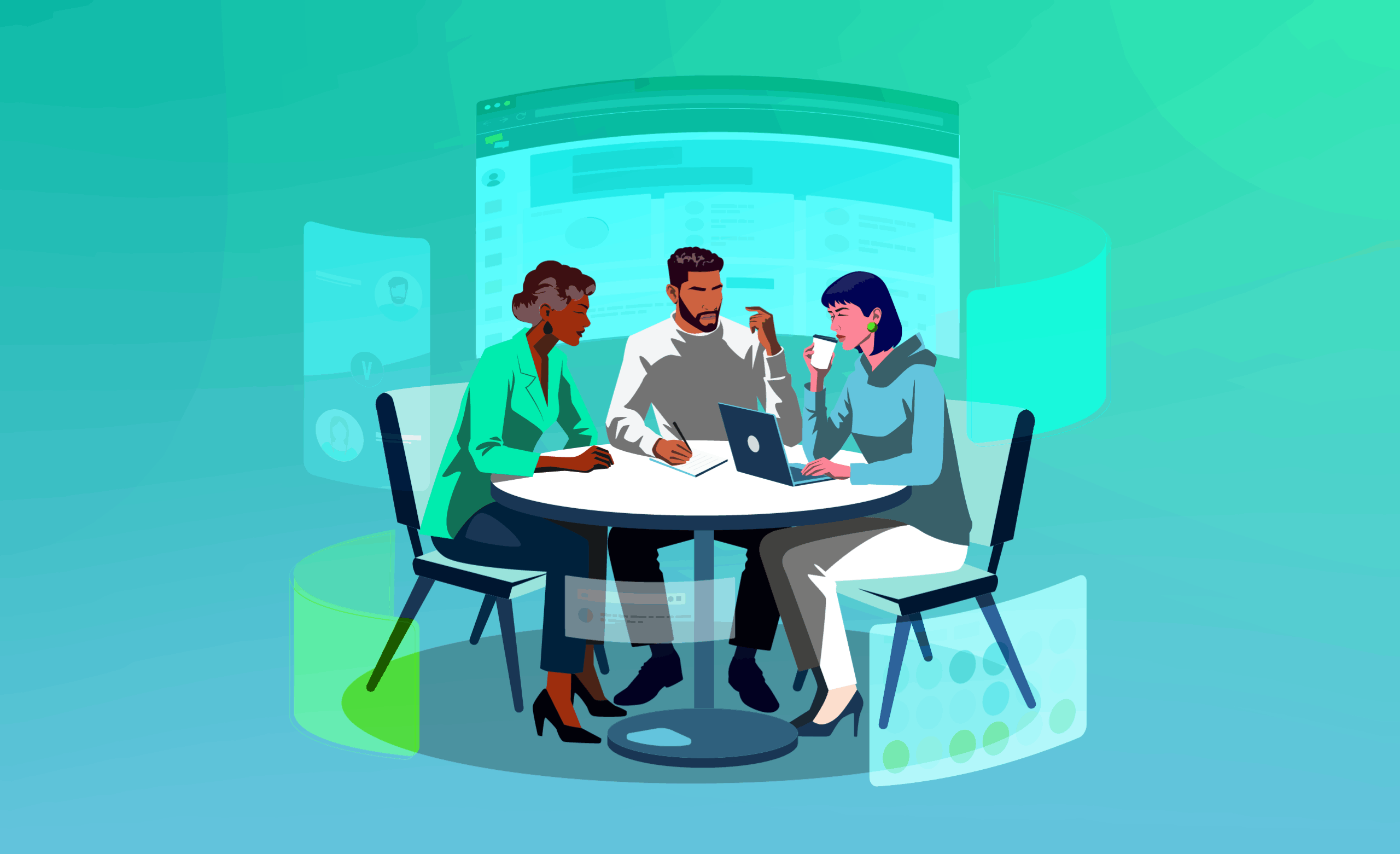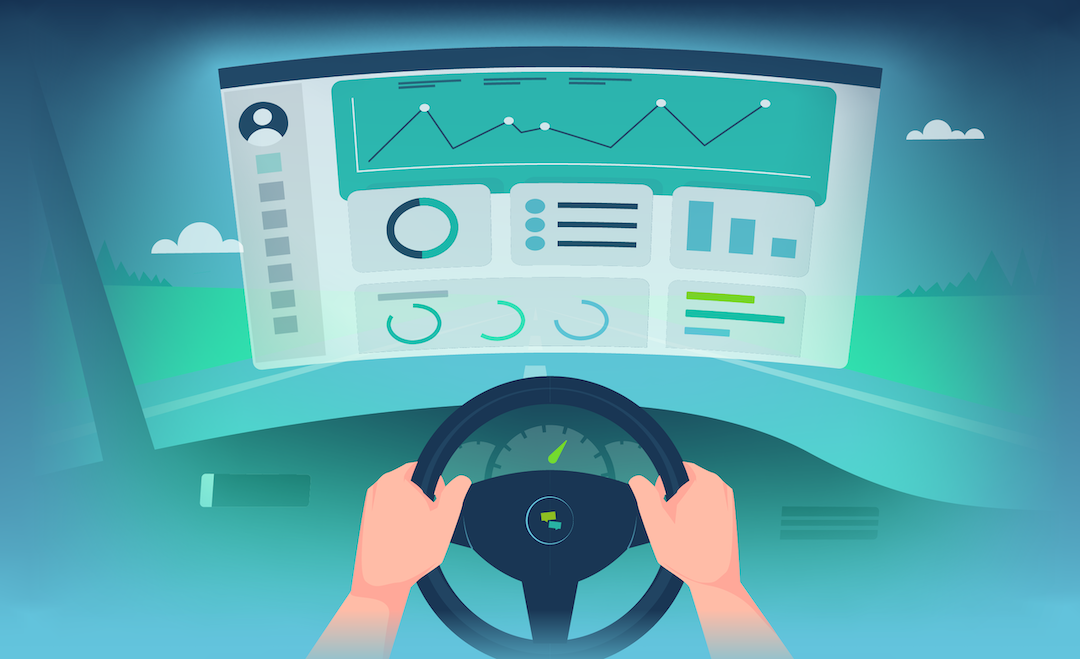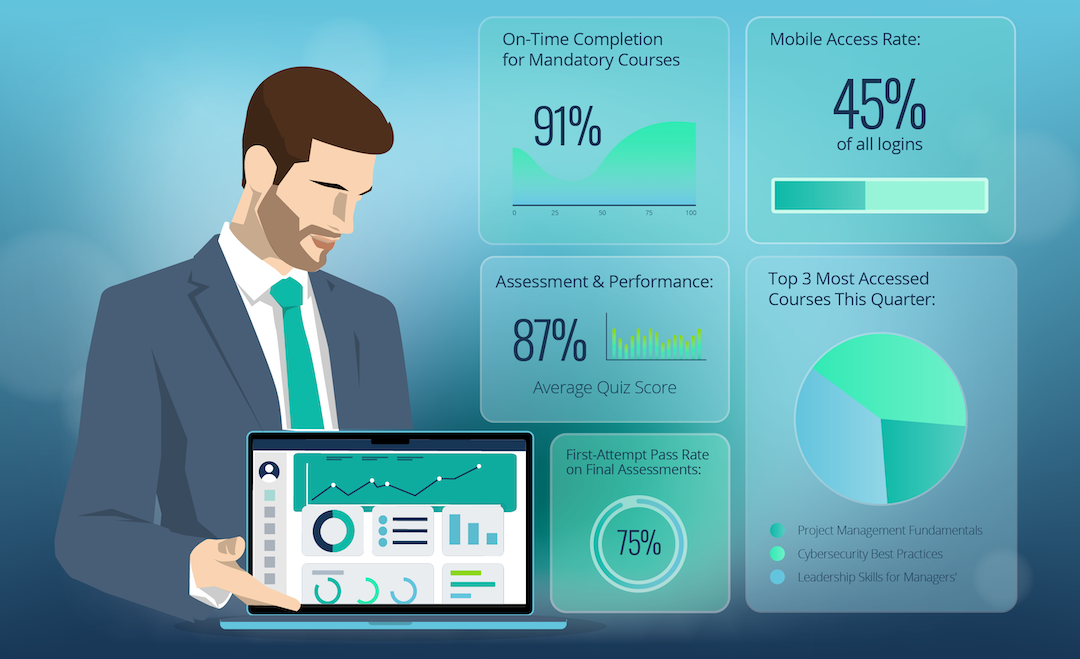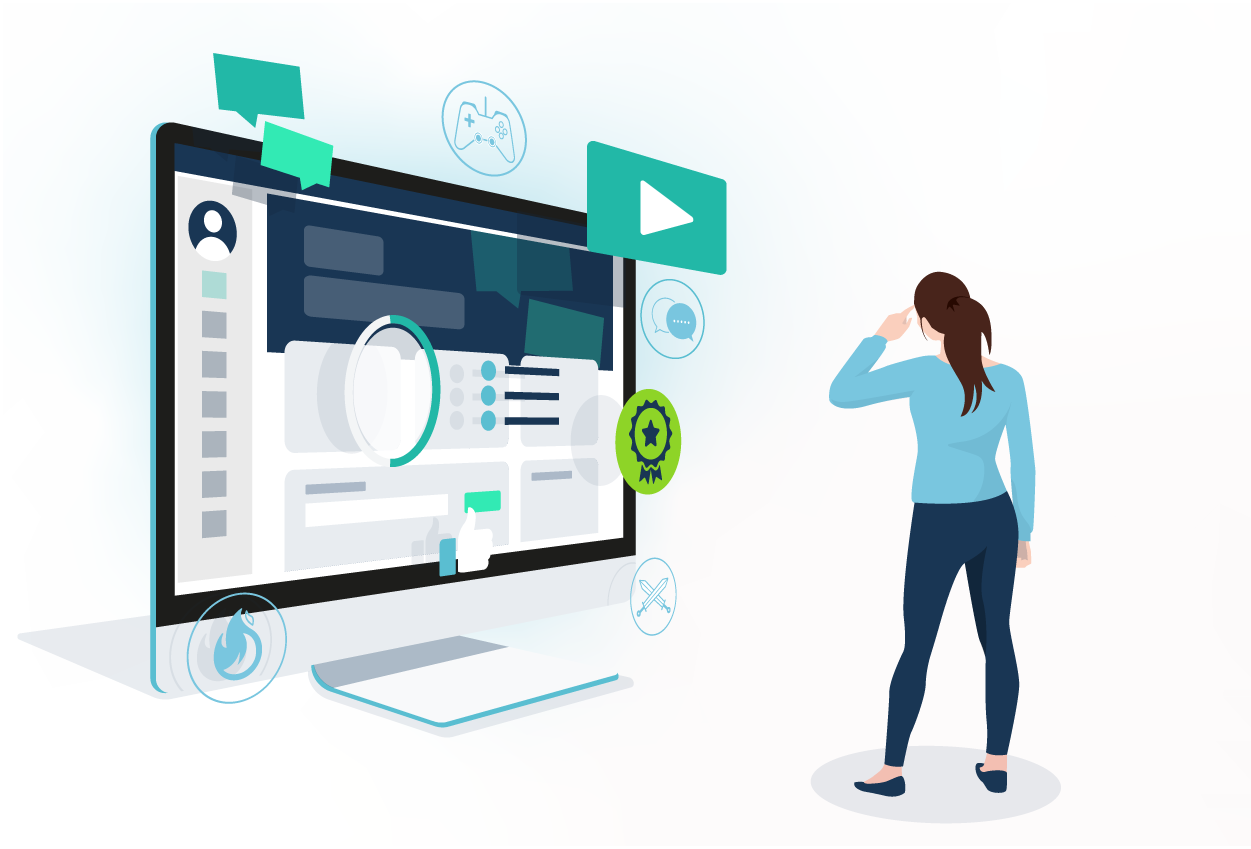 For many decades, the LMS (learning management system) has dominated the learning technology space. However, a new learning platform called the LXP recently emerged to challenge it. This new contender has shook up the industry by finding its own niche within the learning systems market..
For many decades, the LMS (learning management system) has dominated the learning technology space. However, a new learning platform called the LXP recently emerged to challenge it. This new contender has shook up the industry by finding its own niche within the learning systems market..
Today, the LXP market is valued at $500 million, with a healthy projected annual growth rate of 50%. So this begs the question. Will the LXP market eventually overtake the LMS market (which is currently worth $5 billion)?
To answer that, let’s first dig into what an LXP is, how it works, and its defining features. We’ll then discuss the difference between an LXP and an LMS. And once we’ve covered all the fundamentals, we’ll get to the most important bit.
“Mirror, mirror on the wall, who’s the fairer of them all?” We’ll give you all the details you require to decide whether you need a LXP or an LMS.
So without further ado, let’s start with a definition!
What is an LXP?
The term LXP stands for Learning Experience Platform. Simply put, it is a platform that enables users to select learning experiences from an array of personalised or recommended content.
The LXP was initially born out of the desire to address the perceived shortcomings of its predecessor, the LMS.
Older LMSs were known for a prescriptive “push” type of learning. This means that the system was built around the needs of learning administrators. In particular, LMSs helped admins to create mandatory learning pathways that their learners had to complete.
This made LMSs a great fit for compliance-focused training interventions. However, it also fuelled a general distaste for online learning experiences. After all, nobody likes being told what to do.
In this sense, a traditional LMS is like a soup kitchen, where you get what you’re given with little room for exploration. An LXP, on the other hand, is like a trip to the farmers’ market: there’s plenty of exciting content experiences to organically seek out and enjoy.
What Does an LXP Do?
The goal of LXPs was to create a system that championed the needs of learners. As such, it became known as a learner-led “pull” type solution.
When it comes to learning, the main appeal of an LXP lies in its open-library approach. This means that users can easily search, browse and discover content that is relevant to them from a wide catalogue of options.
This content is housed in an open library that can collate material from various sources. For instance, learners have access to company documents and training materials, and can also opt to view videos and eLearning content from external websites or other publishers. This helps users to create their own learning pathways.
In addition, many LXPs enable personalised recommendations that are tailored for each specific learner. In the case of newer LXPs, their systems may utilise AI (artificial intelligence) to create smarter (and automated) recommendations.
LXPs are also seen as platforms that focus on providing a social and collaborative learning environment. They tend to offer social features which support peer-to-peer interactions and sharing.
The Evolution of the LXP
To understand how the LXP came about, let’s go back two decades.
The LMSs of this time enjoyed uncontested popularity. And they earned it! For years, learning management systems have successfully helped L&D professionals to manage their learners’ online training programmes. Their design centred on empowering admins to effectively push, track and report on their employees’ learning activities.
Around this time, the learning landscape began to evolve to keep up with new learning approaches and technologies. The explosion of the web opened up online users to a large repository of information. Furthermore, with the emergence of social media, informal learning approaches became even more popular.
Some companies decided to capitalise on these trends and launched new learning platforms. Soon after, renowned industry analyst Josh Bersin noticed their rapid rise. He observed how these new platforms seemed to deliver a more user-centric experience.
To help define these new-age learning platforms, he coined a new term: ‘Learning Experience Platforms’’. And the term has stuck ever since.
Key Features of an LXP
Similar to an LMS, there are a multitude of features you can expect to find on an LXP. To make things simple for you, we’ve broken down the top three features below.
1. User-Centric Experience

A user-centric experience is anything that makes the learning journey a smoother ride. As you might expect, it focuses on the comfort of the learner.
The experience may be made smoother by incorporating online games, social learning, personalisation, gamification, and adding narrative to formal learning. All of these aspects help to create optimum user engagement.
In fact, 87% of employees agree that gamification would make them more productive. As such, the best LXPs are those which offer these features within their system.
LXPs often mimic the modern and sleek interfaces of popular media or content sites. If you’re on the hunt for an LXP, don’t be surprised when you see vendors label themselves the ‘Netflix of learning’. These platforms often come with powerful search functionality, an array of content types and an easily navigable interface.
2. Personalised Recommendations
Have you ever fallen prey to a Netflix binge? You’re not alone. Many people can’t seem to stop at one TV show (or film), thanks to the platform’s powerful recommendation engine. Netflix always seems to know exactly what kind of show we want to watch next, and is always ready with a timely recommendation on their homepage.
So how do they do this? The answer is through contextualisation. Specifically, personalised recommendations provide content interventions that consider each learner’s unique circumstances and context. This approach is a great way to selectively scale down all of your content, so that you’re only offering relevant learning experiences to your end users.
Like Netflix and Amazon Prime Video, many LXPs can contextualise content by employing artificial intelligence. This AI feeds a recommendations engine that helps to guide learners throughout their journey. Note that the engine doesn’t tell learners that they have to complete the content — just that it is likely to be of interest.
Moreover, LXPs will often utilise chatbots to help provide further recommendations. Learners can ‘talk’ to these chatbots, share interests and be fed a new set of training content.
The best part of all this? Everything’s automated, so admins can simply focus on finding more content to feed their knowledge-hungry user base!

3. Social Interaction
In general, LXPs are strong at promoting informal learning experiences. As such, it is little wonder that they have a strong social learning focus. After all, observing and replicating how others behave is a big part of human nature. In fact, according to the 70:20:10 model, social learning accounts for 20% of all learning.
On an LXP, you get the full social experience. This usually includes:
- Collaborating through social news feeds
- The opportunity to chat with Experts
- Interacting on custom discussion groups
- And live chat functionality for real-time interaction and feedback
Social learning executed in this fashion will also appeal to younger workforces. Millennials and Generation Z have been raised on a diet of social media, mobile communication and video chat.
And the fun doesn’t stop there. Social learning generates other awesome by-products such as team-building, skill-sharing and learner engagement.
How Does an LXP Work?
The defining quality of an LXP is its unfettered approach to delivering recommended content for end-users. So how does this work?
According to Josh Bersin, LXPs have evolved to recommend content in three ways:
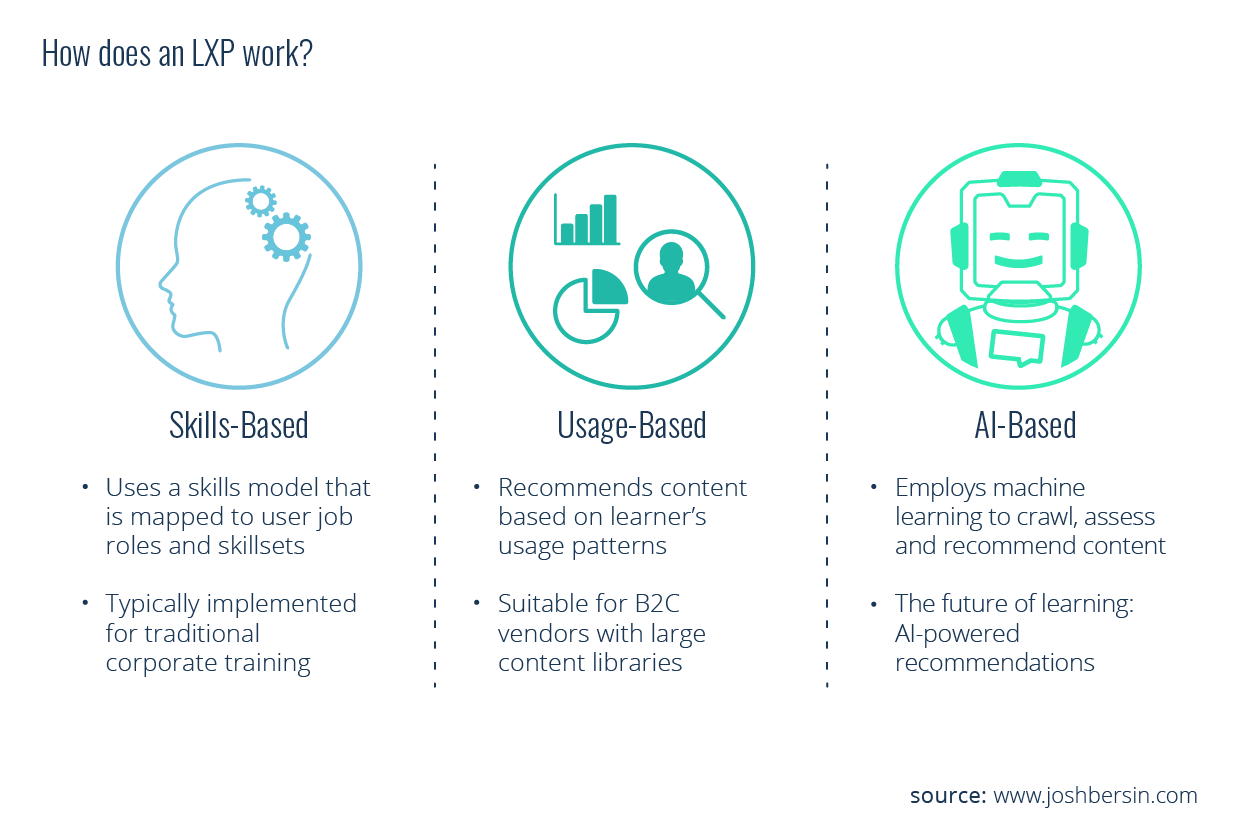
1. Skills-Based Learning
A skills-based recommendations model is most common among standard LXPs. This model delivers recommendations based on skill level and job profiles. This is typically achieved through skills-based tagging.
In this case, content and courses are tagged with various ‘skills’ or ‘competencies’. In turn, these tags will be linked to particular job roles or development pathways. This then allows the system to recommend learning programmes tied to the learner’s career path or job profile.
Some vendors will integrate with existing HR systems to collect and map skill data. They then use this information to match learners to the right learning opportunities.
However, Josh Bersin says that this kind of learning is insufficient. A skill-based approach fails to address the context of the learner’s working environment.
He asserts that today’s companies should focus on building ‘capabilities’ over desired skills. A capability is a broader set of skills, which should align with a company’s strategic objectives.
Here’s an example. Let’s take a salesperson. One good skill for them to have is the art of good listening. This is something that can be practiced and improved on over time. However, you couldn’t successfully sell by just listening. You also need to be able to qualify opportunities, ask good questions, present well, negotiate and so on.
In turn, developing all these relevant skills will equip you with the capability for effective communication. This capability is what will help you to achieve your sales objectives in various customer scenarios.
As such, it’s important that learning platforms are able to see the wood for the trees. In other words, they shouldn’t get so bogged down in skill-based details, that they forget to harness and develop organisational capabilities.
2. Usage-Based Recommendations
Many LXPs also employ a usage-based model to inform their recommendations.
The system does this by pulling and correlating troves of user activity. Algorithms then use this data to recognise behaviour patterns and interests unique to each user.
The LXP can then recommend content based on the learner’s view history, what other similar learners view and what the wider user-base has engaged with most.
There’s one major problem with this approach. It can negatively impact value-driven learning. Just because something is popular, doesn’t mean it’s good. Unfortunately, usage-based models can sometimes lead to good content being filtered out in favour of popular content.
As a result, learners may miss out on less viewed content that holds meaningful educational value and credibility.
3. AI-Based Content Analysis
Last but definitely not the least is the AI-based model. Josh Bersin has dubbed this approach as the ‘future of learning’.
AI-powered LXPs use a sophisticated recommendation system with the help of machine learning. This enables the software to scan content and perform a deep analysis of the material itself. This helps the system to figure out which content is best suited for each individual learner. Based on relevant data patterns, it is able to provide smarter recommendations over time. This allows the system to come up with sophisticated and personalised recommendations.
For instance, AI-powered LXPs are often used by banks and the extended world of finance. These systems crawl through cybersecurity documentation and recommend the right training for security procedures for these banks.
Needless to say, an AI-powered approach is by far the most advanced model an LXP can use. However, AI in learning and development is still in the early stages of adoption. There is still much work to be done when it comes to truly utilising its potential within learning technology.
LXP vs LMS
What’s The Difference?
LXPs are typically seen as a younger, slicker and hipper counterpart to the older, and slightly stuffy LMS. We don’t believe this is a fair distinction, but we’ll get to that in just a moment!
Past LMSs offered a more linear, rigid learning journey compared to the dynamic learning adventure provided by an LXP. This is due to the varied avenues of learning and engagement they offer.
Earlier LMSs often focused on catering for formal learning experiences (the 10% of the 70:20:10 model). LXPs on the other hand, have whole-heartedly embraced informal learning wherever possible.
Check out the table below for a clear break down of the difference between a traditional LMS and a standard LXP:
Traditional Learning Management System |
Standard Learning Experience Platform |
|
| Content Consumption |
|
|
| Content Granularity |
|
|
| Track Completion |
|
|
| Relevant Content |
|
|
At this point, it may seem that both the LMS and LXP will remain within their functional silos. But in reality, the distinction continues to blur.
As ever, technology evolves over time. It changes in line with the needs and wants of end users, businesses, educational institutions, governments and so on.
Modern LXPs are increasingly embracing content controls, such as to-do lists and compliance-driven training. Similarly, today’s LMSs are embracing learner-led experiences with the inclusion of open access content libraries and AI-driven recommendations. This makes it difficult to draw a clear (and meaningful) distinction between the two types of platform.
Today’s LMSs have progressed immeasurably. NextGen LMSs are now incorporating the best LXP features, alongside their standard functionality set, to deliver maximum impact for today’s modern learners.
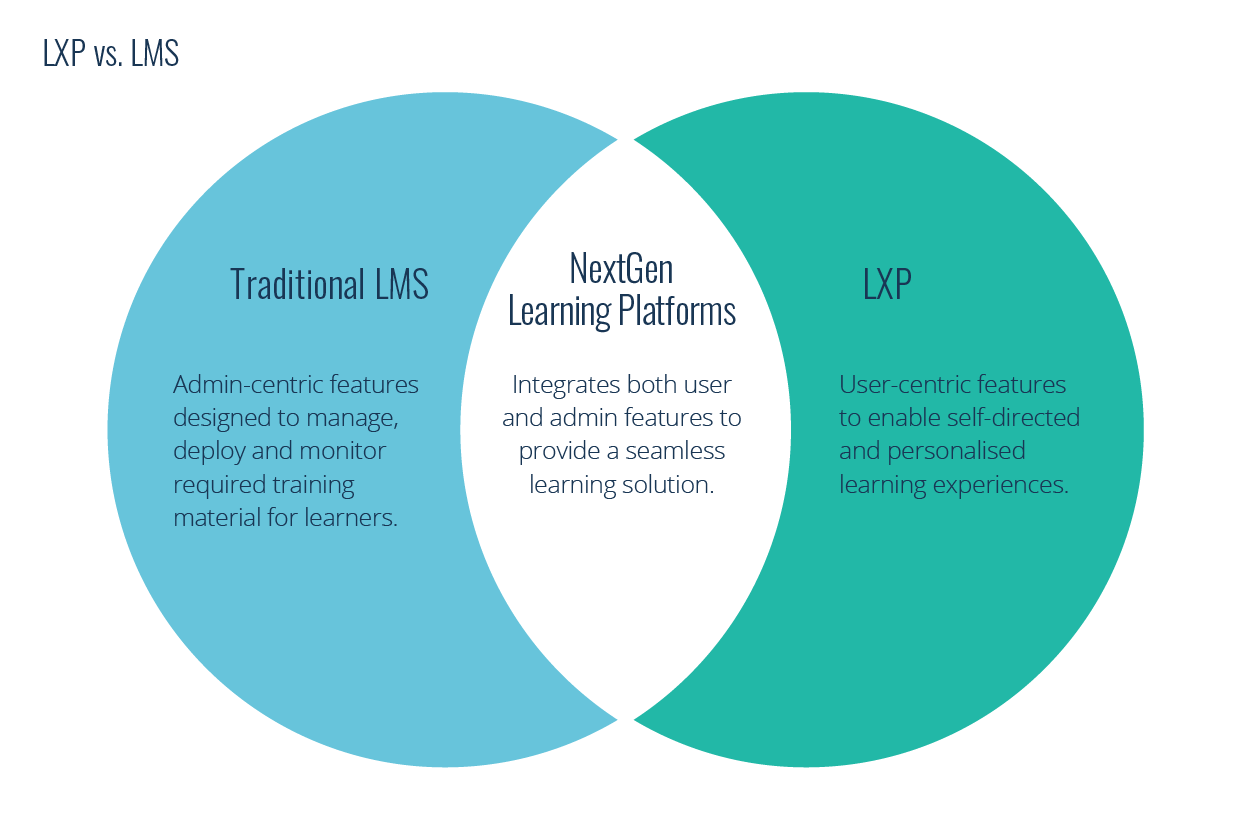
For instance, Growth Engineering’s award-winning LMS is considered a top-of-the-range NextGen LMS. It comes locked and loaded with all the benefits you’d typically get from an LXP. It also includes learner engagement features such as gamification, social learning and personalisation.
Furthermore, it grants admins the freedom to share content however they please. They can make their entire library open access, or carefully craft learning pathways for specific groups of users.
So, Which is Better?
Drum roll please…
BOTH! Yes, you got that right. The right solution for you depends on what you’re trying to achieve.
If you operate in a highly-regulated industry, have a compliance-focused learning programme, or are delivering a certification, you may need the hard and fast content controls offered by an LMS. However, if you’re looking to empower your learners, an LXP may be more suitable.
Of course, the very best solution would incorporate the best of both worlds. This is when your learning technology platform can integrate both user-centric (LXP) and admin-centric (LMS) qualities. In turn, this will ensure a high impact and ultra engaging experience for both learners and admins.
In the next section, we’ll give you some tips on what features to look for from a NextGen learning platform.
What to Look for in Your NextGen Learning Platform
Based on a study conducted by RedThread Research, the best learning systems are those that leverage specific functionalities that address the whole learner experience.
These systems grant equal consideration to both the user and admin experience.
The diagram below illustrates this:
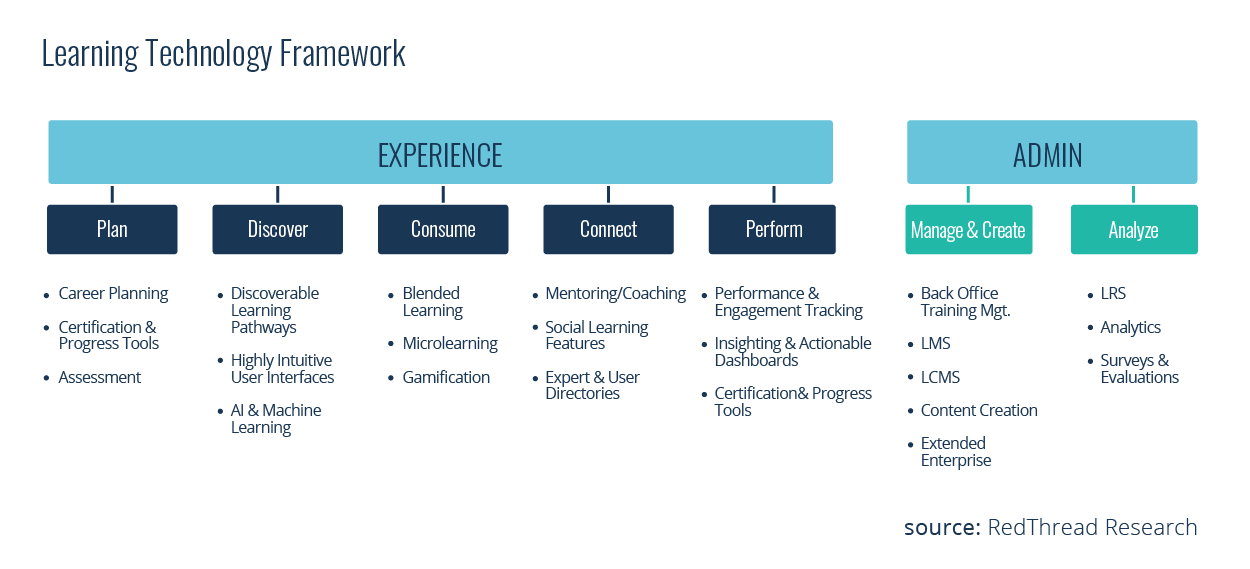
In fact, data shows that forward-thinking organisations prefer a centralised learning system. Specifically, this learning structure is where various features and tools are integrated within one learning suite or ‘ecosystem’. This can include learning products such as an authoring tool, an LMS and a mobile learning app!
As such, here are some features to consider when selecting a NextGen learning solution:
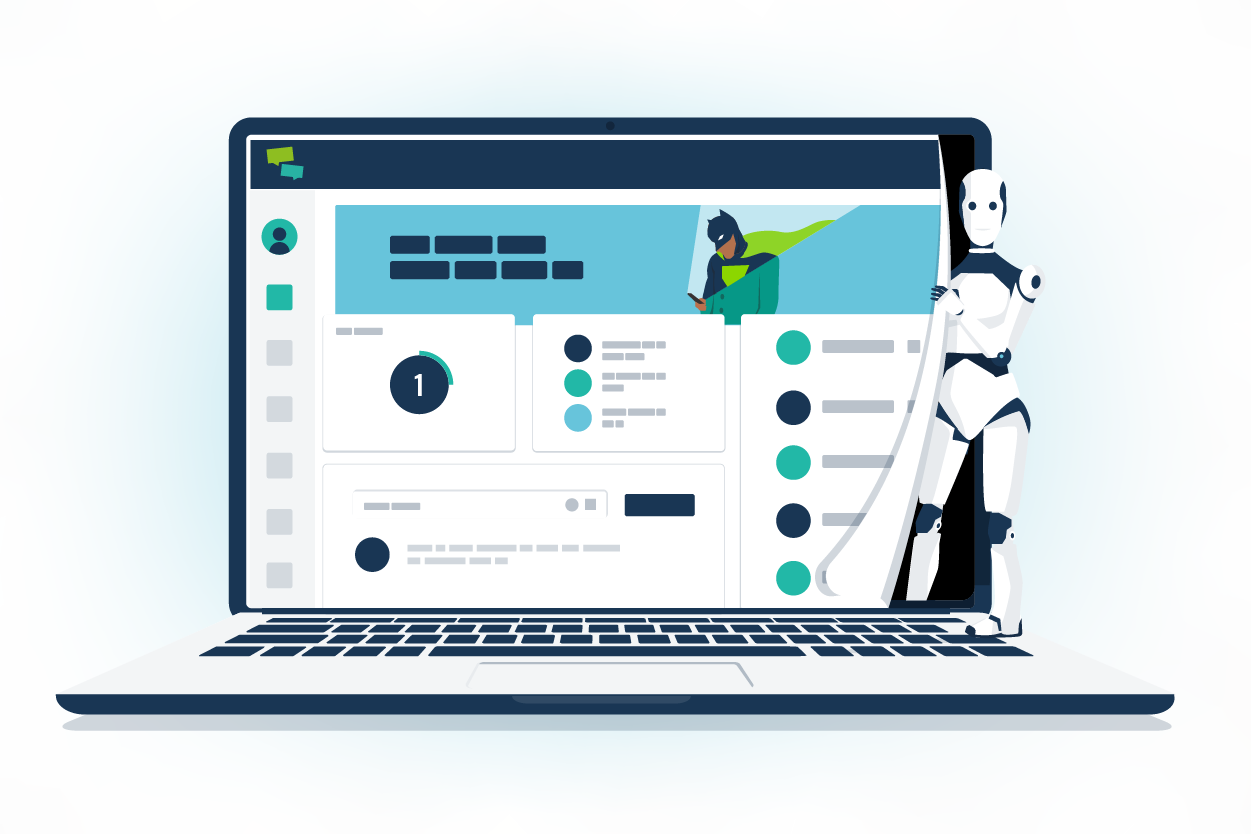
1. An Intuitive & Personalised Learning Interface
A good learning solution should have a highly–intuitive user interface, much like Netflix and Google. Specifically, a next-gen learning platform should have a clean and easy to navigate UI.
What’s more, the interface should adapt based on the user. After all, learners, managers and admins all have different needs.
Did You Know: Personalised learning programmes can boost revenue up to 20%.
2. Gamification Features
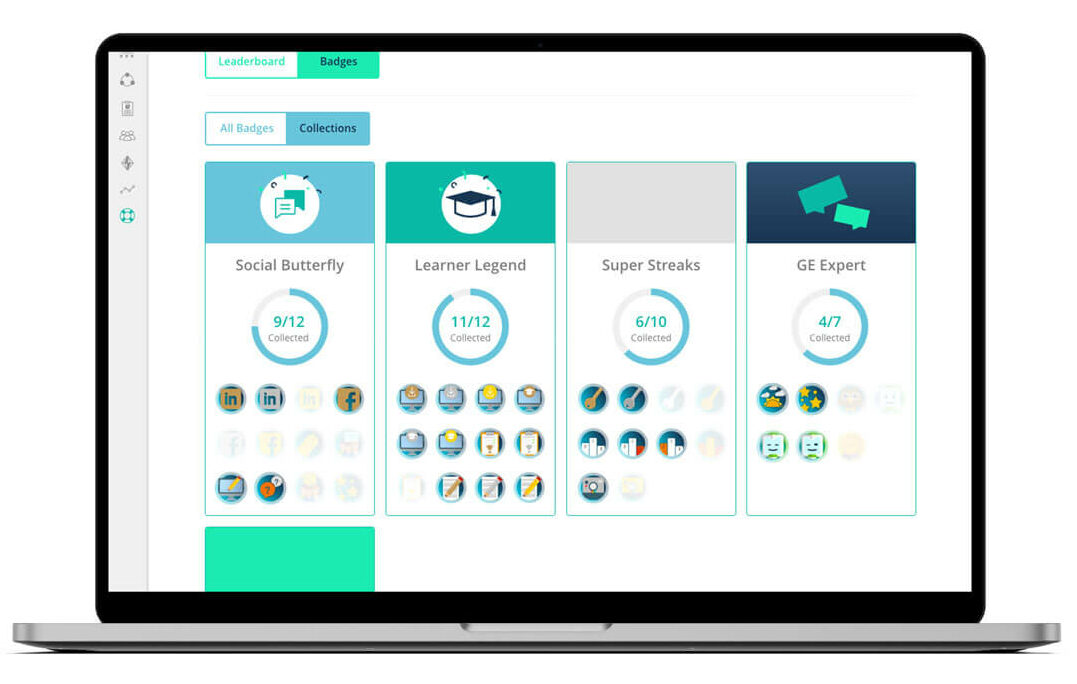
A Gallup report finds that 51% of employees are disengaged in the workplace. This is a shame, as engaged learners are reported to generate as much as 218% increase in revenue. Here is where a gamified learning platform can help!
Gamification is the application of game mechanics to non-gaming scenarios. Game mechanics such as XP, Leaderboards and Badges are some of the features you can find in a gamified platform.
Today, companies across the world are using game mechanics to enhance learner motivation. For instance, our very own gamified system has helped large companies such L’Oréal and HP to hit their engagement targets.
Did You Know: Gamification can boost learner engagement by up to 60%.
3. Social Learning Tools
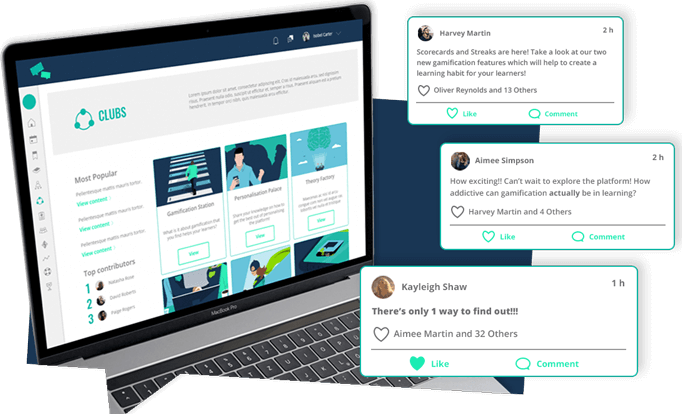 One of the key qualities of a great learning platform is its focus on supporting peer-to-peer learning. It should also be able to connect users with subject matter experts and encourage knowledge sharing.
One of the key qualities of a great learning platform is its focus on supporting peer-to-peer learning. It should also be able to connect users with subject matter experts and encourage knowledge sharing.
For instance, Growth Engineering’s Impact Suite offers a Clubs feature where users can connect and participate in social learning. Our platform also provides an Experts Area, where mentors are able to share their expertise and provide useful feedback.
Did You Know: Learners who use social features spend 30x more hours learning than those who don’t.
4. Rich Reporting Suite
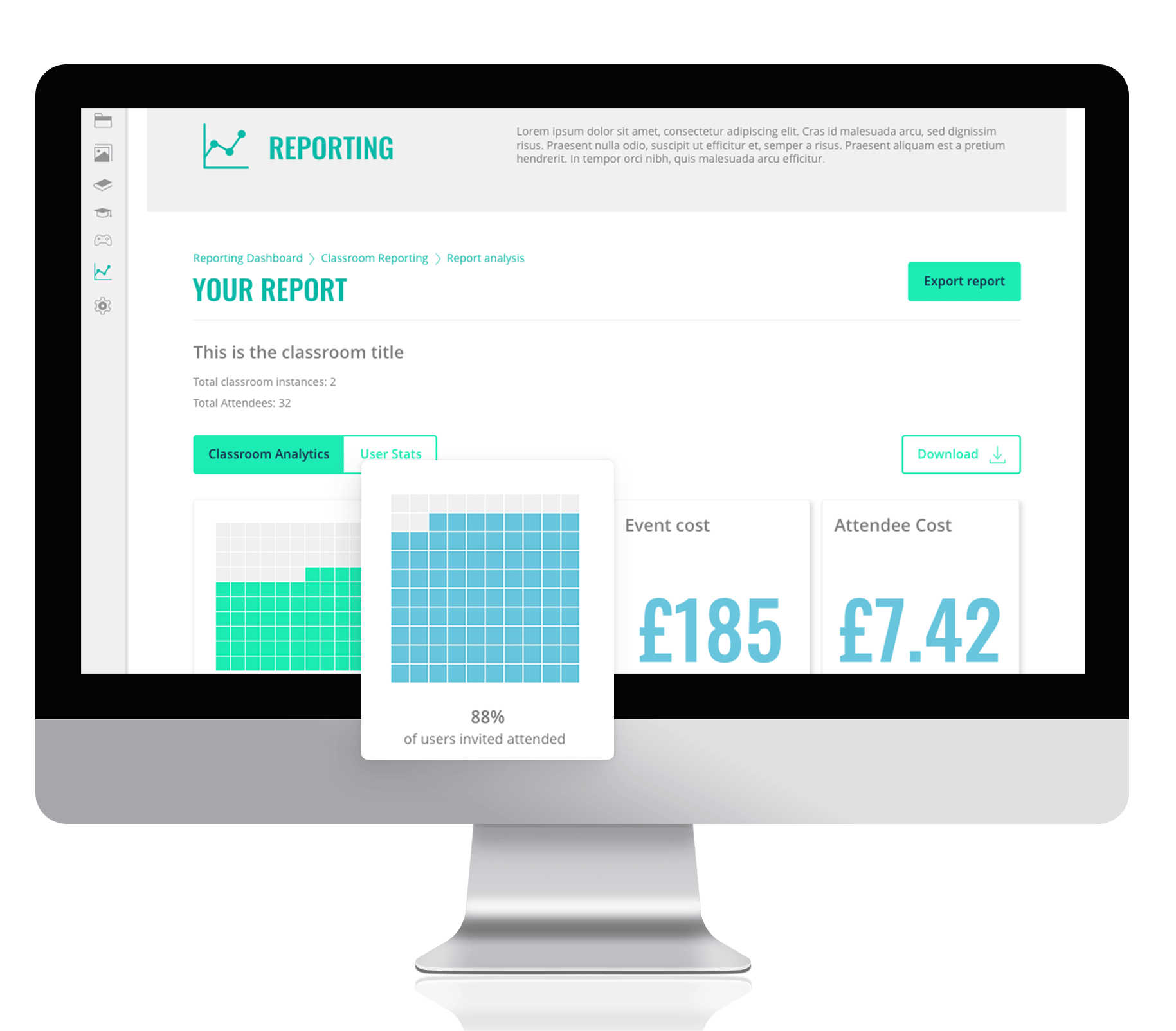 An ideal learning solution should also have advanced insights and reporting capability. This can help you easily track user behaviour, skill gaps, and engagement. In turn, this can help steer a quicker turn-around of improvements within your training programme.
An ideal learning solution should also have advanced insights and reporting capability. This can help you easily track user behaviour, skill gaps, and engagement. In turn, this can help steer a quicker turn-around of improvements within your training programme.
Furthermore, gamification can help you to display learner data in an engaging way. For instance, Scoreboards can help users and admins keep track of their progress, which can further motivate them to keep learning.
Did You Know: 82% of today’s organisations consider reporting and analytics to be an important feature in any learning platform.
5. Deep Integration Capabilities
Any great learning solution must also be able to integrate with other existing business software applications. For instance, your learning platform should be able to integrate with one or more of the following systems:
- Talent Management
- Workforce Management
- Compliance Platform
- Human Resource Information System (HRIS)
- Enterprise Resource Planning (ERP)
- Customer Relationship Management (CRM)
- Payment Processor
- Other Learning Tools (Course Authoring / Mobile App)
Did You Know: 52% of companies report a ‘lack of integration features’ to be one of their biggest frustrations with their current learning platform.
Final Words
When it comes to public perception, the LXP has successfully carved out a niche as a learner-first platform. It aims to empower end-users to learn what they want, when they want, and however they want.
On the other hand, the classic LMS is still perceived by many as an admin-focused platform that’s used to deliver highly-structured learning programmes. However, many still believe in its value for today’s organisations. In fact, as long as there are regulations and mandatory training, legacy LMSs will continue to play a role in the workplace.
In reality, however, it may be misleading to stick to these cookie-cutter definitions. Today’s organisations now prefer integrated systems where learner and admin-centric functionality work together in perfect harmony. As such, modern LXPs and LMSs often now offer features to address both these needs.
Ultimately, the best learning solution is one that integrates all the benefits of what an LXP or LMS can offer. This is what leads to truly engaging and high-impact learning experiences.
For instance, Growth Engineering’s Impact Suite is packed with features designed to deliver the best user and admin experience. We harness the power of gamification, social learning and personalisation to deliver the ultimate engagement engine for learners. What’s more, our learning solution comes with a fully integrated mobile app, authoring tool and a rich reporting suite. Click here to learn more!
Want to level up your learners’ experience? Gamifying your learning programme might just be the solution! Download our white paper ‘Why Gamification Works’ to learn more about the neuroscience of gamification!


